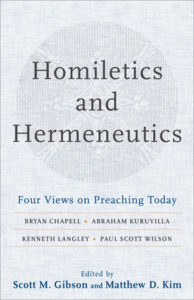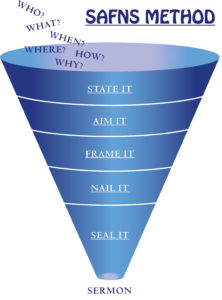 Why is so much preaching today shallow? Many sermons give a superficial examination of the biblical text in the quest for a sound bite theology with its popular appeal. Why? I just finished reading Why Johnny Can’t Preach: The Media Have Shaped the Messengers by T. David Gordon. Gordon challenges us with his first thesis.
Why is so much preaching today shallow? Many sermons give a superficial examination of the biblical text in the quest for a sound bite theology with its popular appeal. Why? I just finished reading Why Johnny Can’t Preach: The Media Have Shaped the Messengers by T. David Gordon. Gordon challenges us with his first thesis.READ WIDELY TO PREACH WELL
 Why is so much preaching today shallow? Many sermons give a superficial examination of the biblical text in the quest for a sound bite theology with its popular appeal. Why? I just finished reading Why Johnny Can’t Preach: The Media Have Shaped the Messengers by T. David Gordon. Gordon challenges us with his first thesis.
Why is so much preaching today shallow? Many sermons give a superficial examination of the biblical text in the quest for a sound bite theology with its popular appeal. Why? I just finished reading Why Johnny Can’t Preach: The Media Have Shaped the Messengers by T. David Gordon. Gordon challenges us with his first thesis.AN ORPHAN GOSPEL
 The gospel preached today is often a man-centered gospel.
The gospel preached today is often a man-centered gospel.What are the characteristics of missional preaching in Acts? Read more…
HOMILETICS AND HERMENEUTICS: A REVIEW

CHRISTMAS THROUGH HEAVEN’S EYES
 Earthly events are the result of heavenly actions. There are cause and effect relationships between heaven and earth. We can see Christmas through heaven’s eyes portrayed for us in Revelation 12:1-5. In this story, there is a woman, a dragon and a baby. The woman is Israel. The baby is Messiah – Jesus – who will rule the nations with a rod of iron. The great, red dragon represents Satan (cf. 12:9). Satan wages war against Israel over the birth of the Messiah.
Earthly events are the result of heavenly actions. There are cause and effect relationships between heaven and earth. We can see Christmas through heaven’s eyes portrayed for us in Revelation 12:1-5. In this story, there is a woman, a dragon and a baby. The woman is Israel. The baby is Messiah – Jesus – who will rule the nations with a rod of iron. The great, red dragon represents Satan (cf. 12:9). Satan wages war against Israel over the birth of the Messiah.Satan is the enemy of God and God’s people. He is determined to rule this world and will do whatever he can to maintain his rule. Milton wrote of Lucifer in Paradise Lost, “To reign is worth ambition, though in hell. Better to reign in hell than to serve in heaven.” Power is what drives Satan. That same ambition is what drives all those who serve Satan in this world. We see Satan’s global strategy pictured in these verses. He works through humans who will swear allegiance to him. In return, Satan offers such pawns the illusions of earthly success, wealth and power. Read more…
A PENTATHLON STRATEGY FOR PREACHERS
 A modern Olympic pentathlon combines five sports into one. An athlete completes all five sports in a single day. The first three sports are fencing, freestyle swimming, and equestrian show jumping. The final two sports combine pistol shooting and running into one event. An athlete must balance her efforts to achieve the highest total score which means that sometimes she must avoid pushing to win in one event to focus on a later event. The total score of all five events is all that matters to win Olympic gold. Read more…
A modern Olympic pentathlon combines five sports into one. An athlete completes all five sports in a single day. The first three sports are fencing, freestyle swimming, and equestrian show jumping. The final two sports combine pistol shooting and running into one event. An athlete must balance her efforts to achieve the highest total score which means that sometimes she must avoid pushing to win in one event to focus on a later event. The total score of all five events is all that matters to win Olympic gold. Read more…SERMON WAYPOINTS
 I just returned from a ten-day boat trip down the eastern coast from Falmouth, Maine to Norfolk, Virginia in Mark Halfacre’s boat Pegasus. Mark was beginning his trip down the intra-coastal waterway to Florida, and I had the privilege of joining him on the first leg. Each night Mark would get out his navigational charts on the iPad and plot his course for the next day. He had to chart a course that avoided shoals under water and buoys above yet led us to the next marina.
I just returned from a ten-day boat trip down the eastern coast from Falmouth, Maine to Norfolk, Virginia in Mark Halfacre’s boat Pegasus. Mark was beginning his trip down the intra-coastal waterway to Florida, and I had the privilege of joining him on the first leg. Each night Mark would get out his navigational charts on the iPad and plot his course for the next day. He had to chart a course that avoided shoals under water and buoys above yet led us to the next marina.THE SAFNS FUNNEL PREACHING METHOD
 Preaching is disciple-making. Our purpose in preaching is to grow fully developed followers of Jesus Christ. We must not neglect the often forgotten word in the Great Commission given to us by Jesus when he called us to teach the people “to observe ALL that I commanded you” (Mt. 28:20). As Paul told the Ephesian elders, “I did not shrink from declaring to you the whole purpose of God” (Acts 20:27). Expository preaching is the best way to achieve the purpose of disciple-making in corporate worship.
Preaching is disciple-making. Our purpose in preaching is to grow fully developed followers of Jesus Christ. We must not neglect the often forgotten word in the Great Commission given to us by Jesus when he called us to teach the people “to observe ALL that I commanded you” (Mt. 28:20). As Paul told the Ephesian elders, “I did not shrink from declaring to you the whole purpose of God” (Acts 20:27). Expository preaching is the best way to achieve the purpose of disciple-making in corporate worship.IS ANYBODY LISTENING?
 We preach our hearts out Sunday after Sunday. Nothing much seems to change! Change comes slowly in small-town churches. The same people sit in the same seats occasionally supplemented by a new family in town. Growth is slow with frequent setbacks. Resources for ministry are limited. “Nice sermon, pastor,” people say as they leave. “Good job.” Another Sunday done. All good. Little changes. Lord, is anybody listening?
We preach our hearts out Sunday after Sunday. Nothing much seems to change! Change comes slowly in small-town churches. The same people sit in the same seats occasionally supplemented by a new family in town. Growth is slow with frequent setbacks. Resources for ministry are limited. “Nice sermon, pastor,” people say as they leave. “Good job.” Another Sunday done. All good. Little changes. Lord, is anybody listening?I agree with Karl Vaters that small church pastors are some of the hardest working and faithful servants of the Lord. He writes that “discouragement is unquestionably the most widespread burden faced by small church pastors.” More small church pastors leave the ministry because of discouragement than any other factor. He notes that the most common cause of discouragement comes from “feelings of failure for not hitting the goals for numerical increase that are set, either by others or by ourselves” (“The 3 Most Common Challenges Small Church Pastors Face – and How to Help,” Pivot Blog, June 1, 2018, Christianitytoday.com). Read more…
MEASURING TO IMPROVE
 Satisfaction is the enemy of improvement. We have to want to improve our preaching before we can improve our sermons. A pastor recently asked me about the purpose behind the preaching cohorts. I explained that the objective is to gather with other pastors to improve our preaching. His response was all too common. He said, “I’m pretty satisfied with my preaching. It is something I think I do well at and enjoy doing.” Here is the danger we all face. We start to settle. What we are doing works. Why fix what is working? We become satisfied, so we stop improving. Read more…
Satisfaction is the enemy of improvement. We have to want to improve our preaching before we can improve our sermons. A pastor recently asked me about the purpose behind the preaching cohorts. I explained that the objective is to gather with other pastors to improve our preaching. His response was all too common. He said, “I’m pretty satisfied with my preaching. It is something I think I do well at and enjoy doing.” Here is the danger we all face. We start to settle. What we are doing works. Why fix what is working? We become satisfied, so we stop improving. Read more…PATHETIC PREACHING
 Apostolic preaching was intentionally persuasive. Rhetoric is the art of persuasion. Therefore, apostolic preaching was rhetorical without being dependent on rhetoric. Unfortunately, the church in the first few centuries moved away from the apostolic model of limited rhetoric to a culturally popular model of professional rhetoric. As society accepted the church, preachers adopted a professional model for preaching, and the sermon took on the rhetorical style of the culture. Modern sermons, too, can bear little resemblance to the apostolic model in our desire to be culturally relevant. Why? What changed? Read more…
Apostolic preaching was intentionally persuasive. Rhetoric is the art of persuasion. Therefore, apostolic preaching was rhetorical without being dependent on rhetoric. Unfortunately, the church in the first few centuries moved away from the apostolic model of limited rhetoric to a culturally popular model of professional rhetoric. As society accepted the church, preachers adopted a professional model for preaching, and the sermon took on the rhetorical style of the culture. Modern sermons, too, can bear little resemblance to the apostolic model in our desire to be culturally relevant. Why? What changed? Read more…
